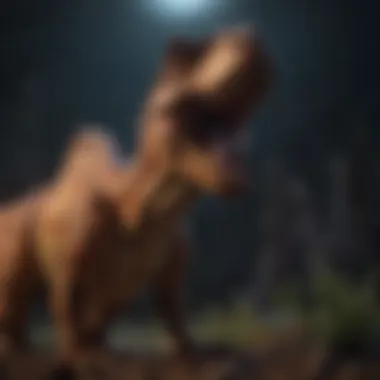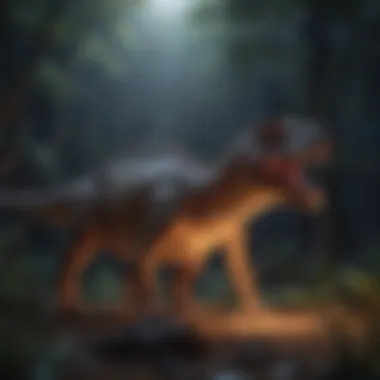Unveiling the Enigmatic Glow of the Night Light Dinosaur


Rock and Fossil Identification
Within the realm of paleontological studies lies the intriguing presence of the night light dinosaur, a fascinating creature shrouded in mystery. When identifying rocks and fossils associated with this enigmatic being, one needs to pay attention to unique characteristics that set them apart from conventional specimens. Look for phosphorescent qualities, luminescent hues, and bioluminescent markers within the rocks and fossils to distinguish those connected to the night light dinosaur. While traditional tools such as UV lights and specialized lenses can aid in identification, the key lies in recognizing the subtle glow that emanates from these extraordinary artifacts.
The essence of the night light dinosaur stems from its nocturnal habits, where it exudes an otherworldly glow, making it a prized find for collectors and researchers alike. As rock and fossil enthusiasts immerse themselves in the world of the night light dinosaur, uncovering these distinct features becomes a rewarding challenge, offering a glimpse into a prehistoric world illuminated by a spectral luminescence.
Unveiling the Night Light Dinosaur
In this pivotal section of the article, we delve into the profound significance of unveiling the night light dinosaur. This exploration serves as the foundation for understanding the enigmatic creature's unique characteristics, behaviors, and evolutionary adaptations. By unraveling the mysteries surrounding the night light dinosaur, we pave the way for a deeper comprehension of its role in prehistoric ecosystems and its contributions to evolutionary biology.
The Origins of Nocturnal Behaviors
The Evolutionary Shift Towards Night Activity
Delving into the evolutionary shift towards night activity unveils a fundamental aspect of the night light dinosaur's behavioral patterns. This shift showcases a remarkable adaptation strategy employed by certain dinosaur species to optimize survival in low-light conditions. By evolving to be more active during the night, these dinosaurs gained a competitive edge in hunting, mating, and overall ecosystem interactions. The significance of this evolutionary choice lies in its ability to enhance the species' chances of survival and propagation.
Adaptations for Low-Light Environments
Exploring the adaptations for thriving in low-light environments illuminates the remarkable resilience of the night light dinosaur. These adaptations encompass a wide array of physical and physiological changes that equip the dinosaur with enhanced sensory perception and efficient energy utilization. From specialized eyesight adaptations to advanced auditory senses, these features enable the dinosaur to navigate and thrive in darkness with unparalleled precision. The advantages of these adaptations are evident in the dinosaur's ability to outcompete diurnal species and secure vital resources to sustain its existence.
Unique Features and Characteristics


Glow-in-the-Dark Elements
The presence of glow-in-the-dark elements within the night light dinosaur's physiology represents a striking marvel of evolution. These bioluminescent features serve multifaceted purposes, including communication, camouflage, and signaling. The distinctive nature of these glowing elements not only sets the night light dinosaur apart from its diurnal counterparts but also underscores its specialized adaptations for nocturnal existence. The advantages conferred by these unique features extend to aiding in mate selection, predator avoidance, and social dynamics within the species.
Sensory Enhancements for Night Vision
Unveiling the sensory enhancements for night vision sheds light on the intricate mechanisms that enable the night light dinosaur to perceive its surroundings in darkness with unparalleled acuity. From heightened olfactory abilities to tactile sensitivity, these sensory enhancements play a critical role in guiding the dinosaur's movements, detecting prey, and avoiding potential threats. The evolutionary advantages of these sensory adaptations are profound, offering the dinosaur a strategic edge in its nocturnal pursuits and reinforcing its position as a formidable predator in the ancient ecosystem.
Paleontological Discoveries
Fossil Evidence of Nocturnal Behavior
Exploring the fossil evidence of nocturnal behavior provides valuable insights into the past behaviors and ecologies of the night light dinosaur. These fossil findings offer concrete proof of the dinosaur's nocturnal tendencies, supported by anatomical features that align with nocturnal adaptations. By scrutinizing these fossils, paleontologists unveil a rich tapestry of behavioral cues that paint a vivid picture of the dinosaur's activities under the cover of darkness. The significance of this evidence extends to enhancing our comprehension of dinosaur behavior and ecosystem dynamics during the Mesozoic era.
Impact on Understanding Dinosaur Ecology
Behavioral Patterns and Adaptations
In this section, we delve into the vital aspect of behavioral patterns and adaptations exhibited by the night light dinosaurs. Understanding these behaviors is crucial in unraveling the mysteries surrounding these enigmatic creatures. The interplay between innate behaviors and evolutionary adaptations sheds light on their survival strategies and ecological niche. By delving deep into their behavioral repertoire, we can decipher how these dinosaurs thrived in the cover of darkness, showcasing exceptional evolutionary traits tailored for their nocturnal lifestyle. The exploration of behavioral patterns and adaptations not only enriches our knowledge of ancient ecosystems but also underscores the evolutionary marvel of these captivating creatures.
Hunting and Feeding Strategies


Stealth Tactics Under the Cover of Darkness
Stealth tactics under the cover of darkness represent a pinnacle of adaptation for night light dinosaurs. The ability to move undetected in low-light conditions conferred a significant strategic advantage during hunting expeditions. Their camouflage prowess and silent movements epitomized the symbiosis between anatomical features and behavioral intelligence. By capitalizing on stealth tactics, these dinosaurs could approach prey surreptitiously, ensuring successful predation without alerting potential targets. This section delves into how the evolution of stealth tactics revolutionized hunting behaviors among these prehistoric nocturnal predators.
Utilization of Night Vision for Prey Detection
The utilization of night vision for prey detection revolutionized the hunting landscape for night light dinosaurs. Their enhanced visual acuity under low-light environments empowered them to detect subtle movements and track prey with remarkable precision. The evolutionary refinement of night vision conferred a distinct edge in the competitive realm of nocturnal predation. By examining the nuances of how these dinosaurs harnessed their heightened visual senses, we unravel the intricate relationship between sensory adaptations and hunting prowess. This section unveils the strategic advantages and inherent complexities of relying on night vision for effective prey detection.
Communication and Social Interactions
Nocturnal Calls and Signals
Nocturnal calls and signals played a pivotal role in communication dynamics among night light dinosaurs. The resonant calls and intricate signals facilitated social cohesion, mating rituals, and territorial assertions in dim-lit environments. Understanding the nuances of nocturnal communications provides a window into the complex interpersonal relationships within dinosaurian communities. This section elucidates the significance of acoustic communication in shaping social hierarchies and fostering group cohesion among these enigmatic creatures.
Group Dynamics in Dim-Lit Environments
Group dynamics in dim-lit environments offered a fascinating glimpse into the intricate social structures of night light dinosaurs. The collaboration strategies, hierarchical arrangements, and cooperative behaviors exemplified in dim-lit settings underscored the adaptive advantages of communal living. By exploring the interplay between group dynamics and environmental luminosity, we unravel the evolutionary underpinnings of collective behaviors in nocturnal species. This section unravels the subtleties of interaction dynamics within nocturnal dinosaurian communities, shedding light on the cohesiveness and resilience endowed by collaborative strategies.
Significance in Paleontological Studies
In the realm of paleontology, the Enigmatic Glow of the Night Light Dinosaur serves as a crucial focal point for understanding prehistoric ecosystems and evolutionary trajectories. The exploration of these nocturnal creatures sheds light on the intricate interplay between different species in ancient habitats, offering valuable insights into the dynamics of past environments. By dissecting the behavioral patterns and adaptations of night light dinosaurs, researchers can unravel the complexities of ecosystems long gone, piecing together a more comprehensive picture of the ecological web that existed millions of years ago.


The study of night light dinosaurs not only widens our understanding of prehistoric life but also provides a glimpse into how these organisms influenced the evolutionary pathways of other species. By examining their role in food chains and ecological niches, scientists can infer the cascading effects of nocturnal behaviors on entire ecosystems, demonstrating the interconnectedness of all living beings in ancient habitats. Through meticulous analysis of fossil evidence and ecological reconstructions, researchers are able to reconstruct the past with greater clarity, enriching our knowledge of the evolutionary forces that have shaped life on Earth.
Insights into Prehistoric Ecosystems
Role of Night Light Dinosaurs in Food Chains
The role of night light dinosaurs in food chains represents a fundamental aspect of their significance in paleontological studies. These creatures occupied unique positions as nocturnal predators or scavengers, playing a crucial role in regulating the dynamics of prehistoric ecosystems. Their specialized adaptations for low-light environments allowed them to exploit resources that diurnal species could not access, contributing to a more diverse and resilient ecosystem.
Night light dinosaurs brought a distinctive set of characteristics to the food chain, such as enhanced sensory capabilities for night vision and camouflaging mechanisms to evade detection. These traits not only impacted their hunting and foraging strategies but also influenced the behaviors of other organisms within the same ecosystem. By examining their position in the food web, researchers can tease apart the intricate relationships between different species, illuminating the complex interactions that shaped ancient biomes.
Ecological Niches Occupied by Nocturnal Species
The ecological niches occupied by nocturnal species offer a window into the specialized habitats that night light dinosaurs inhabited. These creatures carved out unique ecological roles within their ecosystems, exploiting niches that were inaccessible to their diurnal counterparts. By thriving in darkness and utilizing biomimetic glow-in-the-dark elements, nocturnal species like the light dinosaur diversified the ecological landscape, filling vital roles that influenced the balance of nature.
The adaptation of nocturnal traits allowed these species to capitalize on resources that remained untapped during the daytime, illustrating their evolutionary success in adapting to a specific niche environment. However, this specialization also came with inherent risks, as the reliance on low-light conditions made them more vulnerable to environmental changes that affected their hunting grounds. Understanding the ecological niches of nocturnal species provides key insights into their evolutionary strategies and the broader implications for prehistoric ecosystems.
Future Research and Exploration
In the ever-evolving realm of paleontological studies, the exploration of future research avenues regarding the night light dinosaur represents a significant endeavor. Researchers and scientists are continuously driven by the curiosity to uncover more insights into the nocturnal behaviors, adaptations, and ecological roles of these enigmatic creatures. By delving into the uncharted territories of the prehistoric world, future research opens doors to a deeper understanding of evolutionary processes and ecological dynamics, shedding light on the complex web of relationships within ancient ecosystems.
Advancements in technology play a pivotal role in shaping the future of paleontological research on night light dinosaurs. The integration of cutting-edge imaging techniques revolutionizes the way fossils are analyzed and interpreted, allowing for a more detailed examination of skeletal structures, anatomical features, and even potential soft tissue remains. Through the use of imaging technologies, researchers can visualize and reconstruct the biology and unique characteristics of these extinct creatures with unprecedented clarity and accuracy.
Moreover, the simulation of nighttime environments in research provides a novel approach to studying the habits and interactions of nocturnal species. By recreating the conditions of the past, scientists can gain valuable insights into how night light dinosaurs navigated their surroundings, hunted for prey, and communicated with one another under the veil of darkness. This innovative methodology bridges the gap between past and present, offering a glimpse into the intricate ecological dynamics of ancient ecosystems and the challenges these creatures faced in their daily lives.
Field discoveries and expedition findings serve as the cornerstone of paleontological research, offering a tangible link to our prehistoric past. Uncovering new species of night light dinosaurs not only expands the existing taxonomic knowledge but also provides clues to the diversity and adaptation strategies of these creatures. Each new finding adds another piece to the puzzle of ancient biodiversity, contributing to our understanding of the evolutionary pathways and ecological niches occupied by nocturnal species.
Furthermore, reconstructing behavioral patterns from fossil sites allows researchers to infer the social structures, communication methods, and hunting strategies employed by night light dinosaurs. By interpreting fossilized remains within the context of their geological settings, scientists can piece together the intricate puzzle of prehistoric behaviors, offering valuable insights into the lives of these fascinating creatures. Through meticulous analysis and reconstruction, a narrative of the past emerges, illuminating the hidden stories and secrets of the night light dinosaurs for generations to come.







